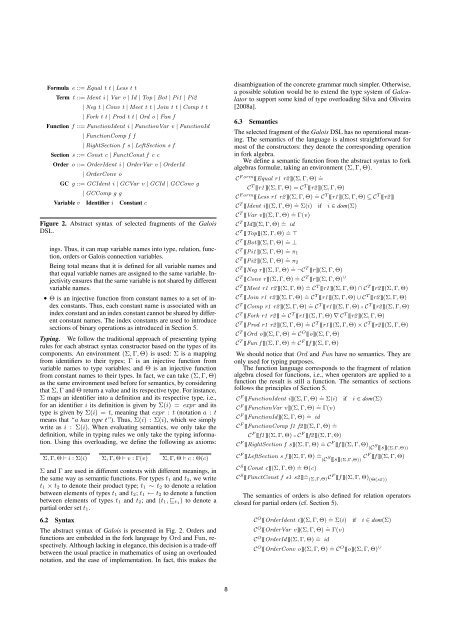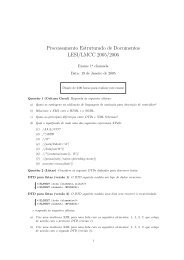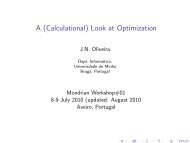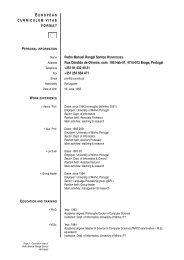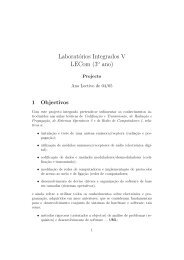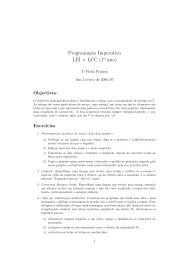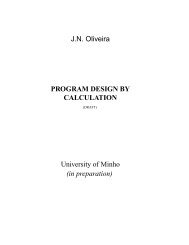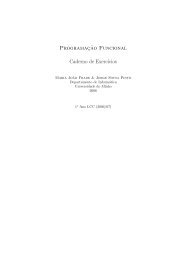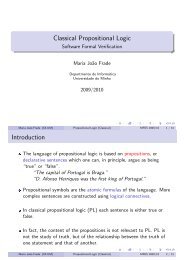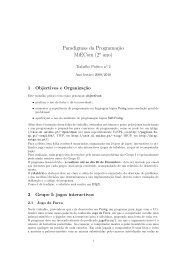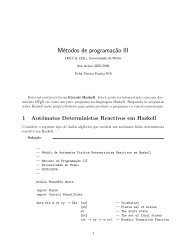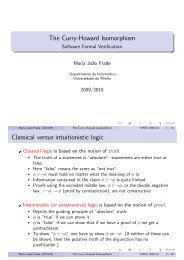Galois
Galois
Galois
You also want an ePaper? Increase the reach of your titles
YUMPU automatically turns print PDFs into web optimized ePapers that Google loves.
Formula e ::= Equal t t | Less t t<br />
Term t ::= Ident i | Var v | Id | Top | Bot | Pi1 | Pi2<br />
| Neg t | Conv t | Meet t t | Join t t | Comp t t<br />
| Fork t t | Prod t t | Ord o | Fun f<br />
Function f ::= FunctionIdent i | FunctionVar v | FunctionId<br />
| FunctionComp f f<br />
| RightSection f s | LeftSection s f<br />
Section s ::= Const c | FunctConst f c c<br />
Order o ::= OrderIdent i | OrderVar v | OrderId<br />
| OrderConv o<br />
GC g ::= GCIdent i | GCVar v | GCId | GCConv g<br />
| GCComp g g<br />
Variable v Identifier i Constant c<br />
Figure 2. Abstract syntax of selected fragments of the <strong>Galois</strong><br />
DSL.<br />
ings. Thus, it can map variable names into type, relation, function,<br />
orders or <strong>Galois</strong> connection variables.<br />
Being total means that it is defined for all variable names and<br />
that equal variable names are assigned to the same variable. Injectivity<br />
ensures that the same variable is not shared by different<br />
variable names.<br />
• Θ is an injective function from constant names to a set of index<br />
constants. Thus, each constant name is associated with an<br />
index constant and an index constant cannot be shared by different<br />
constant names. The index constants are used to introduce<br />
sections of binary operations as introduced in Section 5.<br />
Typing. We follow the traditional approach of presenting typing<br />
rules for each abstract syntax constructor based on the types of its<br />
components. An environment (Σ, Γ, Θ) is used: Σ is a mapping<br />
from identifiers to their types; Γ is an injective function from<br />
variable names to type variables; and Θ is an injective function<br />
from constant names to their types. In fact, we can take (Σ, Γ, Θ)<br />
as the same environment used before for semantics, by considering<br />
that Σ, Γ and Θ return a value and its respective type. For instance,<br />
Σ maps an identifier into a definition and its respective type, i.e.,<br />
for an identifier i its definition is given by Σ(i) = expr and its<br />
type is given by Σ(i) = t, meaning that expr : t (notation a : t<br />
means that “a has type t”). Thus, Σ(i) : Σ(i), which we simply<br />
write as i : Σ(i). When evaluating semantics, we only take the<br />
definition, while in typing rules we only take the typing information.<br />
Using this overloading, we define the following as axioms:<br />
Σ, Γ, Θ ⊢ i : Σ(i) Σ, Γ, Θ ⊢ v : Γ(v) Σ, Γ, Θ ⊢ c : Θ(c)<br />
Σ and Γ are used in different contexts with different meanings, in<br />
the same way as semantic functions. For types t 1 and t 2, we write<br />
t 1 × t 2 to denote their product type; t 1 ∼ t 2 to denote a relation<br />
between elements of types t 1 and t 2; t 1 ← t 2 to denote a function<br />
between elements of types t 1 and t 2; and (t 1, ⊑ t1 ) to denote a<br />
partial order set t 1.<br />
6.2 Syntax<br />
The abstract syntax of <strong>Galois</strong> is presented in Fig. 2. Orders and<br />
functions are embedded in the fork language by Ord and Fun, respectively.<br />
Although lacking in elegance, this decision is a trade-off<br />
between the usual practice in mathematics of using an overloaded<br />
notation, and the ease of implementation. In fact, this makes the<br />
disambiguation of the concrete grammar much simpler. Otherwise,<br />
a possible solution would be to extend the type system of Galculator<br />
to support some kind of type overloading Silva and Oliveira<br />
[2008a].<br />
6.3 Semantics<br />
The selected fragment of the <strong>Galois</strong> DSL has no operational meaning.<br />
The semantics of the language is almost straightforward for<br />
most of the constructors: they denote the corresponding operation<br />
in fork algebra.<br />
We define a semantic function from the abstract syntax to fork<br />
algebras formulæ, taking an environment (Σ, Γ, Θ).<br />
C F orm [[Equal r1 r2 ]](Σ, Γ, Θ) . =<br />
C T [[r1 ]](Σ, Γ, Θ) = C T [[r2 ]](Σ, Γ, Θ)<br />
C F orm [[Less r1 r2 ]](Σ, Γ, Θ) . = C T [[r1 ]](Σ, Γ, Θ) ⊆ C T [[r2 ]]<br />
C T [[Ident i]](Σ, Γ, Θ) . = Σ(i) if i ∈ dom(Σ)<br />
C T [[Var v]](Σ, Γ, Θ) . = Γ(v)<br />
C T [[Id]](Σ, Γ, Θ) . = id<br />
C T [[Top]](Σ, Γ, Θ) . = ⊤<br />
C T [[Bot]](Σ, Γ, Θ) . = ⊥<br />
C T [[Pi1 ]](Σ, Γ, Θ) . = π 1<br />
C T [[Pi2 ]](Σ, Γ, Θ) . = π 2<br />
C T [[Neg r]](Σ, Γ, Θ) . = ¬C T [[r]](Σ, Γ, Θ)<br />
C T [[Conv r]](Σ, Γ, Θ) . = C T [[r]](Σ, Γ, Θ) ∪<br />
C T [[Meet r1 r2 ]](Σ, Γ, Θ) . = C T [[r1 ]](Σ, Γ, Θ) ∩ C T [[r2 ]](Σ, Γ, Θ)<br />
C T [[Join r1 r2 ]](Σ, Γ, Θ) . = C T [[r1 ]](Σ, Γ, Θ) ∪ C T [[r2 ]](Σ, Γ, Θ)<br />
C T [[Comp r1 r2 ]](Σ, Γ, Θ) . = C T [[r1 ]](Σ, Γ, Θ) ◦ C T [[r2 ]](Σ, Γ, Θ)<br />
C T [[Fork r1 r2 ]] . = C T [[r1 ]](Σ, Γ, Θ) ∇ C T [[r2 ]](Σ, Γ, Θ)<br />
C T [[Prod r1 r2 ]](Σ, Γ, Θ) . = C T [[r1 ]](Σ, Γ, Θ) × C T [[r2 ]](Σ, Γ, Θ)<br />
C T [[Ord o]](Σ, Γ, Θ) . = C O [[o]](Σ, Γ, Θ)<br />
C T [[Fun f ]](Σ, Γ, Θ) . = C F [[f ]](Σ, Γ, Θ)<br />
We should notice that Ord and Fun have no semantics. They are<br />
only used for typing purposes.<br />
The function language corresponds to the fragment of relation<br />
algebra closed for functions, i.e., when operators are applied to a<br />
function the result is still a function. The semantics of sections<br />
follows the principles of Section 5.<br />
C F [[FunctionIdent i]](Σ, Γ, Θ) . = Σ(i) if i ∈ dom(Σ)<br />
C F [[FunctionVar v]](Σ, Γ, Θ) . = Γ(v)<br />
C F [[FunctionId]](Σ, Γ, Θ) . = id<br />
C F [[FunctionComp f1 f2 ]](Σ, Γ, Θ) . =<br />
C F [[f1 ]](Σ, Γ, Θ) ◦ C F [[f2 ]](Σ, Γ, Θ)<br />
C F [[RightSection f s]](Σ, Γ, Θ) . = C F [[f ]](Σ, Γ, Θ) (C S [[s]](Σ,Γ,Θ))<br />
C F [[LeftSection s f ]](Σ, Γ, Θ) . = (C S [[s]](Σ,Γ,Θ)) CF [[f ]](Σ, Γ, Θ)<br />
C S [[Const c]](Σ, Γ, Θ) . = Θ(c)<br />
C S [[FunctConst f s1 s2 ]] . = (Σ,Γ,Θ) C F [[f ]](Σ, Γ, Θ) (Θ(s2 ))<br />
The semantics of orders is also defined for relation operators<br />
closed for partial orders (cf. Section 5).<br />
C O [[OrderIdent i]](Σ, Γ, Θ) . = Σ(i) if i ∈ dom(Σ)<br />
C O [[OrderVar v]](Σ, Γ, Θ) . = Γ(v)<br />
C O [[OrderId]](Σ, Γ, Θ) . = id<br />
C O [[OrderConv o]](Σ, Γ, Θ) . = C O [[o]](Σ, Γ, Θ) ∪<br />
8


